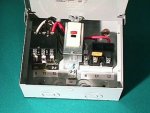oldsparky52
Senior Member
- Location
- Wilmington, NC USA
I need to see if it is possible to provide GFCI protection (of course at a "reasonable" cost, lol ) on a circuit that will be fed from an existing NQOD panel that is 3-phase 240V, no neutral, and has a line to ground voltage of around 138V. (I know y'all will want to know how this voltage came about, so here goes. The building service is 208Y/120, there were some loads that required 240V, so what they did was to install a buck/boost transformer on each of the power legs feeding a panel to get 240V line to line, which of course brings the line to ground voltage up to about 138).
What SQ D has told me is that their GFCI breaker will not work because it requires the neutral connection for the electronics inside the breaker. They started to entertain the idea of just wiring the neutral wire to ground, but when they found out the line to ground voltage was 138, then said it would damage the breaker.
So, now I need to try to come up with a way to deal with this if possible. I found this product, and was curious if anyone has used these before, and does anyone know if this product uses a line to ground connection internally (sort of like what used to be done with some electronic dimmers)?
Short of coming up with a usable product, the only thing I can think to do is to feed a small transformer with 240V in and 240/120V out. I think that's going to be a bit more work than the customer will want, and I understand that is not my problem but his (but we are friends and I would like to offer the most cost effective, code compliant way to do this).
(A special thanks to Dennis for pointing out the possible problem in using this product).
What SQ D has told me is that their GFCI breaker will not work because it requires the neutral connection for the electronics inside the breaker. They started to entertain the idea of just wiring the neutral wire to ground, but when they found out the line to ground voltage was 138, then said it would damage the breaker.
So, now I need to try to come up with a way to deal with this if possible. I found this product, and was curious if anyone has used these before, and does anyone know if this product uses a line to ground connection internally (sort of like what used to be done with some electronic dimmers)?
Short of coming up with a usable product, the only thing I can think to do is to feed a small transformer with 240V in and 240/120V out. I think that's going to be a bit more work than the customer will want, and I understand that is not my problem but his (but we are friends and I would like to offer the most cost effective, code compliant way to do this).
(A special thanks to Dennis for pointing out the possible problem in using this product).

